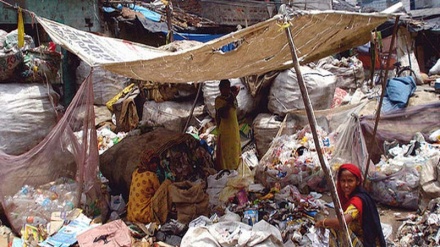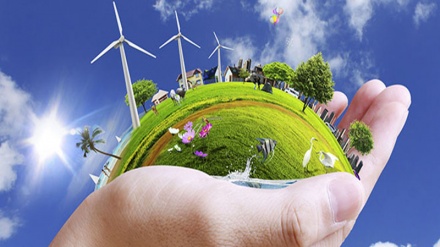We only have one planet to live on (2)
Welcome to the 2nd weekly episode of the series We Only Have One Planet to Live On. Today, we speak of the elements that form and shape the environment.
We said that environment consists of whatever is included in the life of humans, animals, and plants. Water, soil, air, and light are the factors, which upon change positively and/or negatively impact the existence and growth of creatures. The European Economic Council, in definition of environment, has pointed out these factors and has mentioned that the environment is comprised of water, soil, air, and outer and inner elements which are related to the existence of every living creature. Meanwhile, among these elements, air is more necessary than water and food. Living creatures can live for a few days or few weeks without food. But, they can only live for a few minutes in the absence of air. Access to healthy and clean air is the natural right of human beings. However, the swift developments which have taken place in the past hundred years have polluted the air for all living creatures. A rise in carbon emission of factories which consume fossil fuels; the carbon emissions by autos; burning oil wells; and raging fire across forests have caused air pollution, threatening the health of living creatures on the planet.
Currently, air pollution is a global concern which has caused countless problems, especially in large, populous cities. Scientists believe that one of the main factors which have contributed to air pollution and global warming in the past hundred years is the emission of greenhouse gases in atmosphere. The greenhouse gases include carbon dioxide, nitrogen dioxide, methane, steam, and nitrogen. These greenhouse gases lead to global warming. The studies which have been carried out have revealed that due to emission of greenhouse gases, the planet’s temperature, in the past hundred years, has increased from 0.8 to 3.5 degrees Celsius. The global warming has led to major climate changes in different parts of the world and occurrence of major catastrophes such as droughts, floods, and thunderstorms; while also expediting the melting process of polar icebergs, and inundation of coastal regions.
An accredited and reliable global organization which monitors climate changes, IPCC, in a report, has confirmed a rise in temperature across the world, while blaming the emission of greenhouse gases and pollutants which mankind has created as the root causes of global warming.
Meanwhile, global warming highly contributes to the elimination of water sources, especially in regions such as Central Asia, North Africa, and the large plains of the US.
One of the other important elements of the environment is water; a liquid which has made existence on the planet possible. Although water is one of the most important renewable sources of the planet, it is highly limited. The fact of the matter is that water reserves have been threatened worldwide. Over 40% of the world countries are grappling with shortage of water due to a number of reasons such as the growth of population; development of agriculture; pollution of water sources; and industrial consumption of water. The need for water surges by 3.2% per annum. The World Bank, upon realization of this crisis, had spent nearly $600 billion across the globe prior to the year 2005 to counter drought and the expand water sources.
Meanwhile, water sources are of significant importance in the contemporary world such that governance of water reserves is a contemporary geopolitical topic of importance in the world.
Meanwhile, the low quality of water currents is another crisis which has plagued a number of countries. The rate of contamination of some water currents in many regions of the world has generated concerns. The underground water sources, rivers, and lakes are the main sources of desalinated water, which have been directly exposed to the detrimental activities of mankind. Today, provision of desalinated water has turned into a serious crisis for a number of countries.
Moreover, the chemical contamination of water currents is a major concern. The entry of chemicals of factories; disinfectants used in agriculture; and urban wastewater into water currents has polluted underground and surface waters, claiming the lives of many species to this day. Also the usage of fertilizers, containing nitrates and phosphates, has raised the amount of these elements in water currents, and the swift growth of bacteria and algae. The growth of algae in turn has led to shortage of oxygen in water and death of many aquatics.
The third element of environment is soil; a very thin layer of earth which highly contributes in feeding living creatures. Soil maintains the necessary moisture for plants and moderates the climate. Soil also swiftly disintegrates and neutralizes contaminations and wastes, while recycling the components of these disintegrated wastes. Nowadays, the salinization of fertile soil, acidification and erosion of soil manifest the occurrence of a number of changes in this layer of earth which threatens the environment.
In accordance to global figures, lands cover 13.2 billion hectares worldwide; out of which only 22% are fertile. Even, these fertile soils are currently exposed to erosion and destruction. In accordance to scientific studies, 11% of the global fertile soils have been contaminated to a point of no return. Based on these studies; deforestation, usage of traditional irrigation methods, excessive usage of chemical fertilizers and disinfectants, and excessive grazing of domesticated animals across meadows are some of the main contributors to erosion of soil.
Meanwhile, environmentalists believe that water, soil, heat, light, and air are the physical factors that impact the environment. However, there are also infectious and virulent elements in the environment such as microbes and bacteria which negatively impact humans, animals, insects, and plants. Scientists refer to them as biological elements.
In the view of researchers; religion, culture, economy, politics, justice, injustice, and other aspects of social life can also influence life and the environment.
MR/ME


